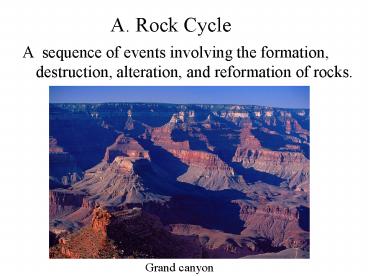A. Rock Cycle - PowerPoint PPT Presentation
1 / 12
Title:
A. Rock Cycle
Description:
A. Rock Cycle A sequence of events involving the formation, destruction, alteration, and reformation of rocks. Grand canyon B. Types of Rocks B. Types of Rocks B ... – PowerPoint PPT presentation
Number of Views:82
Avg rating:3.0/5.0
Title: A. Rock Cycle
1
A. Rock Cycle
- A sequence of events involving the formation,
destruction, alteration, and reformation of
rocks.
Grand canyon
2
(No Transcript)
3
B. Types of Rocks
1. Igneous Rocks (igneous means formed by fire)
Formed by cooling magma
95 of the Earths crust
Most common granite and basalt
Intrusive formed beneath Earths surface
Extrusive formed at Earths surface
4
1. Igneous Rocks (igneous means formed by fire)
granite
basalt
obsidian
pumice
5
B. Types of Rocks
2. Sedimentary Rocks (weathered material)
Found in upper portion of crust
Sediments accumulated weathered material
carried by water, wind, or ice
Most common sandstone, shale, and limestone
Weathering breakdown of rocks into smaller
pieces
Erosion transport of rocks from one place to
another
6
2. Sedimentary Rocks (weathered material)
sandstone
shale
limestone
siltstone
7
B. Types of Rocks
3. Metamorphic Rock (metamorphic means changed in
form)
Formed from pre-existing rocks that are
transformed by high temperatures, high pressures,
or both without melting
Most common marble and slate
8
3. Metamorphic Rock (metamorphic means changed in
form)
marble
slate
quartzite
Mica schist
9
C. Rocks are made of minerals
Minerals naturally formed, generally inorganic,
crystalline solid composed of an ordered array of
atoms having a specific chemical composition
Some such as gold are composed of single elements
Most minerals are compounds
Most minerals are distinguished by their physical
characteristics crystal form, hardness,
cleavage, luster, color, streak, and specific
gravity
10
Most Common Minerals Silicates
Feldspars and quartz are the most common silicates
Silicates contain oxygen and silicon which make
up 46.6 and 27.7 of the Earths crust 95 of
the continental crust is made up of feldspar and
quartz
quartz (amethyst), SiO2
feldspar (orthoclase), KAlSi3O8
11
2nd Most Common Minerals carbonates
The carbonate ion (CO32-) can bond with a variety
of other ions to produce the carbonate minerals.
Calcite is the most common carbonate. All
carbonate dissolve easily in acidic water
azurite (Cu3(CO3)2(OH)2)
calcite (CaCO3)
malachite (Cu2CO3(OH)2)
12
Other Common Minerals oxides and sulfides
Oxides O-2 ions
corundum (Al2O3)
magnetite (Fe3O4)
Sulfides S-2 ions
galena (PbS)
millerite (NiS)































